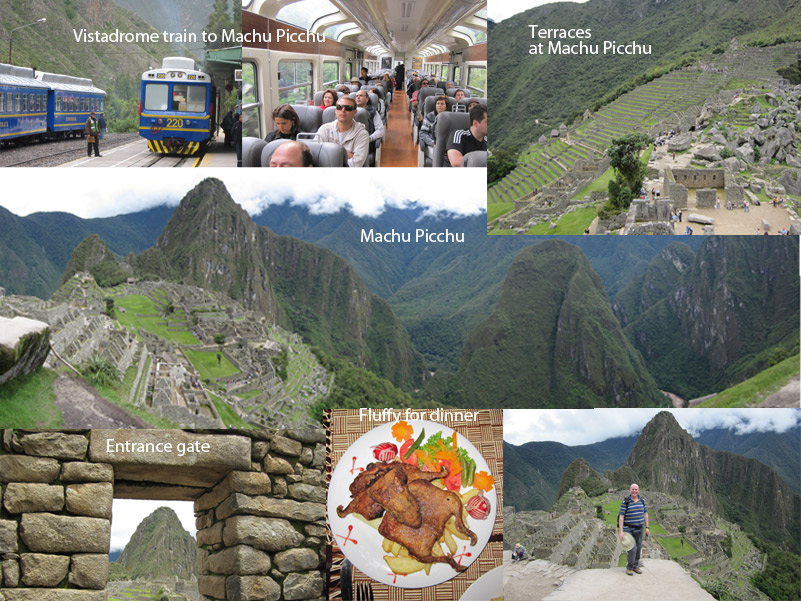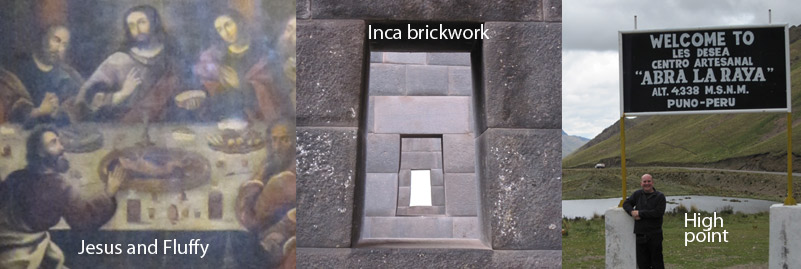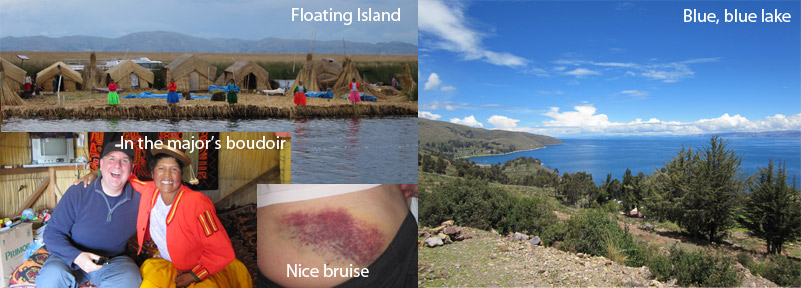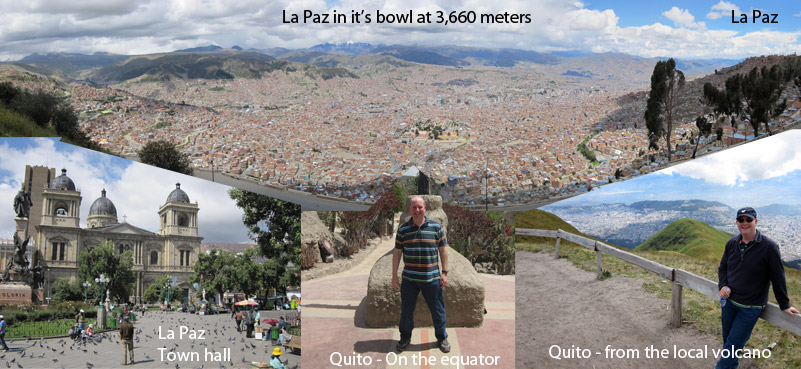Journey to Peru
So I finally make it, arriving at midnight (after a 23 hours of traveling) in Lima, Peru – my first footfall in South America and the luggage carousal had jammed and my bag was still in the USA. The first night at the really upmarket airport hotel was rather lonely and uncomfortable as my pajamas and toothbrush were partying in Houston. However, it was only about 5 hours of discomfort, as we had a 6:00 am flight to the ex-Inca capital of Cusco, so I put back on my rank clothes, hoping my fellow passengers had colds and walked back to the airport. This was a rather atypical flight – normally, you take off, climb, fly a bit and then descend to land. This was more of a climb, fly, land – the whole descending bit was missing as Cusco is at 3,300 meters up in the rather thin air.
This was our first taste of rarefied air that was to be with us for the next weeks. In this low oxygen environment your body instantly tries to adapt – the first noticeable sign is you panting. Every physical and mental action is unfocused, blurry, you are out of breath walking up or down a few steps, and you are constantly peeing as your body frenziedly tries to discharge liquids to thicken the blood. You cannot sleep; you nose cannot physically accommodate the amount of air your need, so your mouth is constantly dry as you to pant massive amounts of air to compensate. You have a craving for liquids and high iron foods as your body ramps up new red-blood cell production – even liver smelt appetizing – first time that has ever happened to me.
The Sacred Valley – Inca heartland
Leaving the airport, we staggered up the 4 steps in to the bus, flopped in the seat for a tour of the Sacred Valley, so called by the Incas due to its unique weather (it has one of the many micro-climates in Peru), geological and agricultural qualities – it also has seams of precious metals running through it. We sampled some delicious corn that is still grown there as we trekked (and puffed) through our first point of call, a market in Chinchero. It was full of llama-themed objects, but sadly no llama underwear – at this stage, over 40 hours since departure, I would have gladly slipped on a pair if they had had any. The highlight of the tour was at end of the valley, in Ollantaytambo, which served as the last pocket of Inca resistance against the Spanish – the highlight for me was not the Inca ruins, but the availability of undies in my size (which shrunk after the first wash). The ruins were spectacular, with tiers of crop growing terraces, amazing masonry and a predisposition for placing things inconveniently up very steep valley walls (why put the grain store next to where you live, surely it would be better on the other side of a valley!?). We spent the night at a hotel which was described itself as “Hotel Sauce, ruins view”, which we were glad to discover looked over the ruins as opposed to being an eyesore spoiling it.

On to Machu Picchu
From Ollantaytambo we were off to our first real highlight – Machu Picchu. There are several options for getting there, hiking, a yucky local flea-ridden train or the luxury Vistadrome Pullman, with great views and a snack. We opted for the easy option and arrived in comfort at the town of Aguas Calientes (now cut off by mud slides) and transferred to a bus up 15 hair-pin bends to the entrance of this amazing Inca town. It was built around 1430 but was abandoned around the time of the Spanish conquest 100 years later. It was rediscovered by in 1911 by Hiram Bingham, an American historian and is absolutely stunning.
We were all breath taken by the site (both literally and figuratively) we just gazed in awe at the ruins, perched on a peak, surrounded by the terraces descending down to the massive bend of the Urubamba River. Taking stacks of pictures an immediate reflex, but nothing on film can capture the majesty of the site. Despite this being the low, rainy season, the sun shone down on us as we were guided through the complex, with its palaces, observatories, farms, houses and fortifications.
We returned to Aguas Calientes that night, hungry and happy. We chose to eat something special and went for guinea pig – we picked Fluffy out of the pen and enjoyed this delicacy of the region (although not much meat and tastes like smoked chicken). We slept well for the first time and the next morning meandered back up to the site, hiked some of the trail and then simply sat, ogling the view for a few hours. The clouds and light constantly played on the ruins, and we watched in peace as rampant llamas (the local lawn mowers) ploughed past knocking other tourists over the edge of the terraces.

Back to Cusco and Catholic Propaganda
We dragged ourselves away, to return to Cusco. Here we saw how the Catholic Church used the “embrace and extend” strategy to ingratiate themselves with the Incas after obliterating their culture (resentment about this is still deep-seated). The Spanish basically moved in, demolishing any Inca temple and building a church on top. However, to make Catholicism more palatable, they incorporated elements of the Inca beliefs. For example, a large fresco of the last supper depicts Jesus and disciples enjoying one of Fluffy’s ancestors and many altars were covered in mirrors as homage to the Inca sun god – things you do not see anywhere else.

Lake Titicaca (Peru and Bolivian Side)
From Cusco we visited Lake Titicaca (at 3,800 meters above sea level, the highest navigable lake in the world and the largest in South America) both on the Peruvian and Bolivian sides. We started in Puno (Peru), in a nice hotel, where the international furniture scraping on parquet floor championships going on all night on the floor above us. The lake was astounding, people speak of the deep blue of the water, but until you see it, it is difficult to comprehend. The standard tour incorporates the primitive, man-made floating islands, where the inhabitants proudly showed off their newly acquired solar cell, light and TV.
From Puno, we drove to the other side of the lake (and Bolivia), as all boat crossings have been banned due to drug smuggling, and fought our way through the border crossing, with ridiculous amounts of red tape. We drove to the (original) town of Copacabana and on to Sun Island.” Sun” is a bit of a misnomer, I would expect heat and light from such a place, but it was cloudy and the “eco-lodge” we stayed at, forwent any such ecologically unfriendly devices such as heating. It was freezing, but the clear night gave some breathtaking views of the night sky and the milky way, not normally seen in the northern hemisphere. It was raining the following morning and going down to the harbor via the “Inca steps”, I slipped and got a HUGE bruise on my cheek (not face), which glowed for the rest of the holiday.

Bolivia and La Paz, Highest Capital and Ecuador, and Quito, 2nd Highest
From there it was a 3 hour drive (with a ferry) to La Paz, capital of Bolivia. Driving in, the view of the city, nestled in a natural bowl, was breathtaking (figuratively this time). Our hotel was dead in the center – it was supposed to be a 5-star hotel, but 5-star Bolivian style is about 3 in Europe. The first thing that got me was the sign in the bathroom that any stain on a towel would mean you had to cough up for a new one. As I showered, I admired my pre-stained towel and wondered if I would have to pay.
The next day a walking tour of La Paz was in order – a gasping experience as the streets are very steep in every direction. The guide books say the witches market is impressive, so we wheezed our way up the street to this area, but was a real disappointment. However, we then stumbled on the most amazing “real” market I have ever seen in my life. This is where the real Bolivians do their shopping, it went on for about 2 miles and every side street had a theme; fruit row, pasta market, toys road, fish avenue, bicycle mews – interestingly all the financial transactions were handled by women – not a man to be seen, except as customers.
The last point of call in this stretch was a flight away – Quito in Ecuador, the 2nd highest capital in South America. The 3 hour flight put us in a country that was a highlight, friendly, non-pushy people, with breath taking views of the volcanoes surrounding the city. The city is also close to the equator and we visited the line standing in the northern and southern hemisphere and watching the sleight of hand as the guides demonstrated how the water vortex in a sink rotated different ways on each side of the line.

But this was not the main highlight of Ecuador, which was to come…
